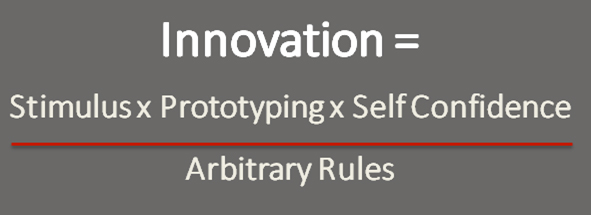Do you want to know the one big secret to stimulating innovation in your team?
It’s simple, let people try out their ideas. Not just create them, but actually try them out. You see, employees need a balance of simulation, prototyping, and self-confidence in order to be comfortable with pitching and trying out new ideas.
This is where the innovation equation comes in. The innovation equation states that innovation equals stimulus times prototyping times self-confidence divided by arbitrary rules.

Let’s break down this equation and discuss the variables to stimulate innovation individually.
Stimulus
Are your business processes stuck in a rut?
What have you done differently lately? If you and your team are alwaysdoing the same thing in the same way, eventually you will end up on a plateau void of innovation, motivation, and engagement.
We need to do something differently in order to stimulate innovative, creative thought. This can be as simple as getting up and going for a walk when you’re stuck on a certain problem and can’t seem to find the answer. It could also mean taking your team offsite for lunch or to visit another business, perhaps a vendor, to learn something new.
These types of experiences help us change our perspectives and stimulate innovation. When we’re physically pulled out of our routine, we’re able to mentally re-evaluate as well. Next, we’ll be thinking about our routine activities and how we can innovate those activities to make them more efficient, higher-quality, etc.
Prototyping
Prototyping translates stimulus into possible real-world solutions for the problem you’re working on. It’s not enough to simply stimulate innovative thought, you need to actually try out the ideas. Try out many different ways to doing something to see which works best. Are some of these ideas going to fail? Yes. You may even have to deal with a dissatisfied customer, boss or colleague as you’re trying them out. That is part of the prototyping process.
There are several ways you can prototype ideas. Sometimes you will use a mixture of these on the same idea, at different stages of the prototyping process. Other types of prototyping will lend themselves better to certain business processes than others. Some examples of different prototypes are:
- Mental rehearsal
- Spreadsheets
- Modeling
- Staging
- Storyboarding
Self Confidence
Know that if your organization is not in the habit of stimulating innovation and change, you have a cultural barrier to inspiring innovation in your team. Fundamentally, people tend to resist change because they are afraid of making mistakes.
Self-confidence is a barrier to innovation that is tough to turn around in an organization. It takes time and a whole lot of trust to reinstate. Know that undermining people’s ideas and never listening to what they have to offer will erode your team’s self-confidence. As the leader, you have to be willing to go out on a limb and take some risks to try out new ideas to inspire self-confidence and stimulate innovation from your team.
Arbitrary Rules
If you are familiar with how fractions work, you know that an increase or decrease in arbitrary rules will have a greater, faster impact on innovation than the variables in the numerator of the equation. However, cutting through the red tape is a very slow process, and it’s difficult to do. That is why, as leaders, we tend to focus our efforts on the top of the equation.
Reducing arbitrary rules in order to stimulate innovation is an important part of the equation, but it looks very different in different organizations and industries. As a leader, work toward eliminating these rules as best as you can, while encouraging innovation through stimulus, prototyping, and self-confidence.
About Crestcom International, LLC.
Crestcom International, LLC is an international leadership development organization, training more than one million leaders for 25,000 businesses in over 60 countries across the globe. Crestcom achieves this through a blend of live-facilitated multimedia video, interactive exercises, and shared learning experiences. Crestcom implements action plans and coaching accountability sessions to ensure measured development in key leadership competency areas. For more information, please contact your local Crestcom representative found here.




